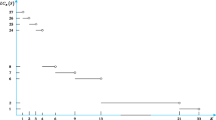Abstract
A well-known operator of sequences over finite field is the derivative, which is used to investigate the complexity of sequences in game theory, communication theory and cryptography. According to the operator, a corresponding complexity of the sequence is called (the first) depth, which also contributes to another two definitions (the second and third depths) by using polynomial factor and high order difference, respectively. For a sequence of period \(n\) over \(F_q\) (a finite field with \(q\) elements and characteristic \(p\)), the three depths are the same as its linear complexity if \(n=p^r \ (r\ge 0)\). This paper focuses on sequence s of period \(n\) with infinite third depth. For cyclic-left-shift-difference operator \(L-1\) on \({\varvec{s}}\), we generally depict circulant matrix structure of the operator \((L-1)^i\) for all \(i>0\) and determine its rank. Furthermore, our results show that the interleaving technique really works with difference operator on producing sequences with good correlation property and long period, which are constructed from 2-level autocorrelation sequences of period \(2^r-1\) except \(m\)-sequences. The method is lightweight since the computation complexity is \(\Theta (N)\) and only the XOR logical operator is used. In addition, ultimate period of a sequence \(\{(L -1)^{i}({\varvec{s}})\}_{i\ge 0}\) is investigated systematically. Some upper bounds on the ultimate period and a formula to determine the least ultimate period are presented.




Similar content being viewed by others
References
Abello J., Pardalos P.M., Resende, M.G.C.: On maximum clique problems in very large graphs. In: Abello J., Vitter J. (eds.) External Memory Algorithms. DIMACS Series on Discrete Mathematics and Theoretical Computer Science 50, pp. 119–130. ISBN 0-8218-1184-3, American Mathematical Society, Providence (1999).
Bar-Yehuda R., Etzion T., Moran S.: Rotating-table games and derivatives of words. Theor. Comput. Sci. 108, 311–329 (1993).
Brualdi R.A.: Introductory Combinatorics, 4th edition. China Machine Press, Beijing (2006).
Dai Z.: On the period of cycling matrix over \(F_q\). Acta Math. Sin. 23(1), 70–77 (1980).
Ding C.: A fast algorithm for determining the linear complexity of sequences over \(GF(p^m)\) with period \(p^n\). IEEE Trans. Inf. Theory 46(6), 2203–2206 (2000).
Ding C., Xiao G.: Stream Cryptography and Its Applications, pp. 39–71. National Defence Industry Press, Beijing (1994).
Etzion T.: The depth distribution-a new characterization for linear codes. IEEE Trans. Inf. Theory 43(4), 1361–1363 (1997).
Etzion T.: Linear complexity of de Bruijn sequences-old and new results. IEEE Trans. Inf. Theory 45(2), 693–698 (1999).
Games R.A.: Cross correlation of \(m\)-sequences and GMW-sequences with the same primitive polynomial. Discret. Appl. Math. 12, 139–146 (1985).
Games R.A., Chan A.H.: A fast algorithm for determining the complexity of a binary sequence with period \(2^n\). IEEE Trans. Inf. Theory 29(1), 144–146 (1983).
Golomb S.W.: Shift Register Sequence. Aegen Park Press, Laguna Hills (1982).
Golomb S.W., Gong G.: Signal Design for Good Correlation for Wireless Communication, Cryptography, and Radar. Cambridge University Press, Cambridge (2005).
Gong G.: Theory and applications of \(q\)-ary interleaved sequences. IEEE Trans. Inf. Theory 41(2), 400–411 (1995).
Gong G.: New designs for signal sets with low cross correlation, balance property, and large linear span: \(GF(p)\) case. IEEE Trans. Inf. Theory 48(11), 2847–2867 (2002).
Gong G., Helleseth T.: A three-valued Walsh transform from decimations of Helleseth–Gong sequences. IEEE Trans. Inf. Theory 58(2), 1158–1162 (2012).
Helleseth T., Kumar P.V., Martinson H.: A new family of ternary sequences with ideal two-level autocorrelation function. Des. Codes Cryptogr. 23(2), 157–166 (2001).
Lidl R., Niederreiter H.: Finite Fields. Cambridge University Press, Cambridge (1983).
Lin S., Costello D.J.: Error Control Coding: Fundamentals and Applications. Englewood Cliffs, Prentice-Hall (1983).
Luo Y., Fu F., Wei V.K.: On the depth distribution of linear codes. IEEE Trans. Inf. Theory 46(6), 2197–2203 (2000).
MacWilliams F.J., Solane N.J.A.: The Theory of Error-Correcting Codes. North-Holland, New York (1997).
Mitchell C.J.: On integer-valued rational polynomials and depth distributions of binary codes. IEEE Trans. Inf. Theory 44(7), 3146–3150 (1998).
Nathanson M.B.: Derivatives of binary sequences. SIAM J. Appl. Math. 21(3), 407–412 (1971).
No J.S., Yang K., Chung H., Song H.Y.: New construction for families of binary sequences with optimal correlation properties. IEEE Trans. Inf. Theory 43(5), 1596–1602 (1997).
Pollard J.M.: Monte Carlo methods for index computation (mod \(p\)). Math. Comput. 32(143), 918–924 (1978).
Robshaw M.J.B.: On evaluating the linear complexity of a sequence of least period \(2^n\). Des. Codes Cryptogr. 4, 263–269 (1994).
Rosen K.H.: Elementary Number Theory and Its Applications, 4th edn, pp. 53–61, 222–229. China Machine Press, Beijing (2004).
Roth R.M.: Private communication to Etzion T.
Teske E.: Speeding Up Pollard’s Rho Method for Computing Discrete Logarithms. Algorithmic Number Theory Seminar ANTS-III. Lecture Notes in Computer Science, vol. 1423, pp. 541–554. Springer, Berlin (1998).
Zeng M., Luo Y., Gong G.: Rotating-table game and construction of periodic sequences with lightweight calculation. In: Proceedings of the IEEE International Symposium of Information Theroy, Boston, MA, pp. 1–6 (2012).
Zhang G., Zhou Q.: Pseudonoise codes constructed by Legendre sequence. Electron. Lett. 38(8), 376–377 (2001).
Acknowledgments
The authors would like to thank the anonymous referees for their valuable suggestions and detailed comments that improved this paper. This work was supported in part by the National 973 Project of China under Grant No. 2013CB338004, the National Natural Science Foundation of China under Grants 61271222, and the Innovation Program of Shanghai Municipal Education Commission under Grant 14ZZ017.
Author information
Authors and Affiliations
Corresponding author
Additional information
Communicated by T. Etzion.
Rights and permissions
About this article
Cite this article
Zeng, M., Luo, Y. & Gong, G. Sequences with good correlation property based on depth and interleaving techniques. Des. Codes Cryptogr. 77, 255–275 (2015). https://doi.org/10.1007/s10623-014-0004-z
Received:
Revised:
Accepted:
Published:
Issue Date:
DOI: https://doi.org/10.1007/s10623-014-0004-z




